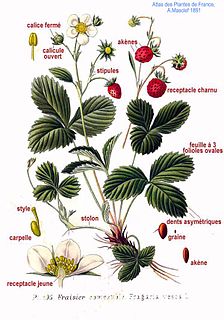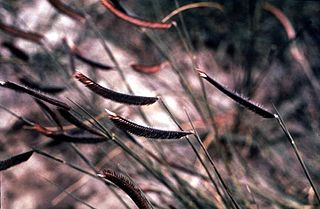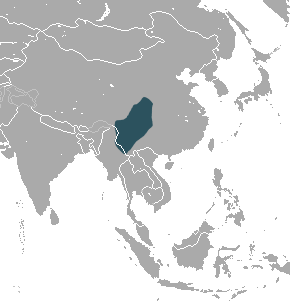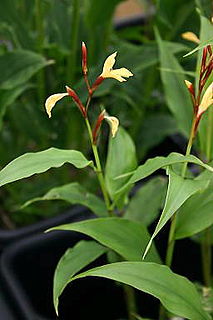
Fragaria is a genus of flowering plants in the rose family, Rosaceae, commonly known as strawberries for their edible fruits. There are more than 20 described species and many hybrids and cultivars. The most common strawberries grown commercially are cultivars of the garden strawberry, a hybrid known as Fragaria × ananassa. Strawberries have a taste that varies by cultivar, and ranges from quite sweet to rather tart. Strawberries are an important commercial fruit crop, widely grown in all temperate regions of the world.

Deutzia is a genus of about 60 species of flowering plants in the family Hydrangeaceae, native to eastern and central Asia, and Central America and also Europe. By far the highest species diversity is in China, where 50 species occur.

Sageretia is a genus of about 35 species of shrubs and small trees in the family Rhamnaceae, native to southern and eastern Asia and northeast Africa. They have small green leaves 1.5–4 cm long, and a leathery multicoloured trunk. The flowers are small and inconspicuous; the fruit is a small edible drupe 1 cm diameter.

Nepenthes gracilis, or the slender pitcher-plant, is a common lowland pitcher plant that is widespread in the Sunda region. It has been recorded from Borneo, Cambodia, Peninsular Malaysia, Singapore, Sulawesi, Sumatra, and Thailand. The species has a wide altitudinal distribution of 0 to 1100 m above sea level, although most populations are found below 100 m and plants are rare above 1000 m. Despite being a widespread plant, natural hybrids between N. gracilis and other species are quite rare.

Bouteloua gracilis, the blue grama, is a long-lived, warm-season (C4) perennial grass, native to North America.

Rhapis is a genus of about 10 species of small palms native to southeastern Asia from southern Japan and southern China south to Sumatra. The species are commonly known as lady palms. They are fan palms, with the leaves with a bare petiole terminating in a rounded fan of numerous leaflets. The plants have thin stems growing to 3–4 m tall, branching at the base, forming clumps and are dioecious, with male and female flowers produced on separate plants.

The gracile shrew mole is a species of mammal in the family Talpidae. It is found in China and Myanmar.

Cynosurus is a genus of Eurasian and North African plants in the grass family. Plants in this genus are known generally as dogstail grass. They are native to the Mediterranean Basin and neighboring regions, but some have been introduced into Australia as well as North and South America.

Mazus is a genus of low-growing perennial plants. It has been placed in various plant families including Phrymaceae, Scrophulariaceae, and recently in the family Mazaceae. Consisting of around 30 species, this genus is generally found in damp habitats in lowland or mountain regions of China, Japan, Southeast Asia, Australia and New Zealand.
Hydrangea gracilis is a species of flowering plant in the family Hydrangeaceae, native to China. It was formally described by W.T. Wang and M.X. Nie in 1981.

Sphagneticola is a genus of flowering plants in the daisy family, Asteraceae. Creeping-oxeye is a common name for plants in this genus.
H. gracilis may refer to:

Cautleya is a small genus of perennial plants of the family Zingiberaceae, found in the eastern Himalayas through to China and Vietnam. It consists of two species of high-altitude tropical and temperate exotic jungle gingers, native to cool forest areas – an unusual habitat for members of the Zingiberaceae. They are grown as ornamental flowering plants.
Ipomoea gracilis is a plant in the bindweed family, Convolvulaceae. It is found in northern and north-eastern Australia.

Periploca is a genus of plants in the family Apocynaceae, first described for modern science by Linnaeus in 1753. It is native to Europe, Asia, and Africa.
- Periploca aphyllaDecne. - Middle East from Sinai to Pakistan
- Periploca calophylla(Wight) Falc. - S China, Nepal, Bhutan, Assam, E Himalayas, Vietnam
- Periploca chevalieriBrowicz - Cape Verde Islands
- Periploca chrysanthaD.S. Yao, X.D. Chen & J.W. Ren - Gansu Province in China
- Periploca floribundaTsiang - Yunnan, Vietnam
- Periploca forrestiiSchltr. - Guangxi, Guizhou, Qinghai, Sichuan, Tibet, Yunnan, India, Kashmir, Myanmar, Nepal
- Periploca graecaL. - Mediterranean
- Periploca hydaspidisFalc. - Kashmir
- Periploca laevigataAiton - Canary Islands, Savage Islands
- Periploca linearifoliaQuart.-Dill. & A. Rich - Ethiopia
- Periploca nigrescensAfzel. - W Africa
- Periploca refractifoliaGilli - Tanzania
- Periploca sepiumBunge - widespread across much of China
- Periploca tsiangiiD. Fang & H.Z. Ling - Guangxi Province in China
- Periploca visciformis(Vatke) K. Schum. - Somalia

Molineria is a genus of flowering plants. In the APG III classification system, it is placed in the family Hypoxidaceae. It is native to Southeast Asia, China, the Indian Subcontinent, Papuasia, and Queensland.
- Molineria capitulata(Lour.) Herb. - China, Indian Subcontinent, Southeast Asia, Papuasia, Queensland; naturalized in Mexico, Central America, West Indies, Argentina, Mauritius, Réunion
- Molineria crassifoliaBaker - Nepal, Assam, Bhutan, Sikkim, Yunnan, Arunachal Pradesh
- Molineria gracilisKurz - southern China, Assam, Bhutan, Nepal, Cambodia, Thailand, Vietnam
- Molineria latifolia(Dryand. ex W.T.Aiton) Herb. ex Kurz - China, Bangladesh, Indochina, Philippines, western Indonesia
- Molineria oliganthaC.E.C.Fisch. - Assam
- Molineria prainianaDeb - Assam, Bhutan
- Molineria trichocarpa(Wight) N.P.Balakr. - southern India, Sri Lanka

Cautleya gracilis is a perennial herbaceous plant in the family Zingiberaceae. It is found in the Himalayas through to south China and Vietnam. It is cultivated as an ornamental garden plant, hardy to a few degrees of frost.
Ponerorchis gracilis is a species of plant in the family Orchidaceae. It is commonly known as delicate amitostigma. It is widespread across much of eastern Asia. It has been reported from Japan, Korea, Taiwan, and China.
Trailliaedoxa is a monotypic genus of flowering plants in the family Rubiaceae. The genus contains only one species, viz. Trailliaedoxa gracilis, which is endemic to south-central China. It is also the only species in the tribe Trailliaedoxeae.

Bambusa textilis, also known as slender bamboo, clumping bamboo and weaver's bamboo, is a species of bamboo in the Poaceae (grasses) family that is native to China. The subspecies var. gracilis is heavily cultivated in Australia.














